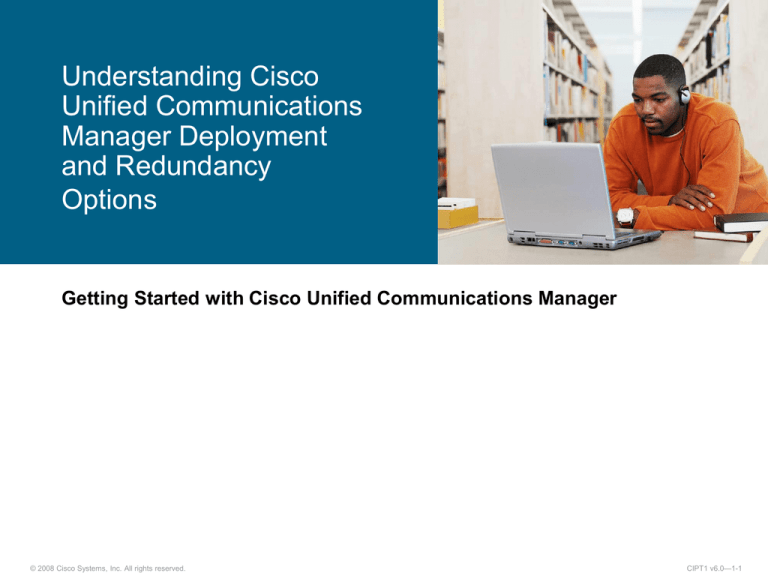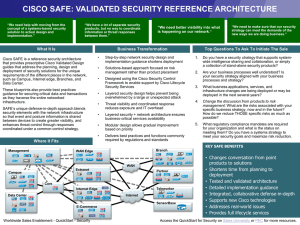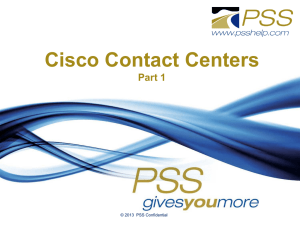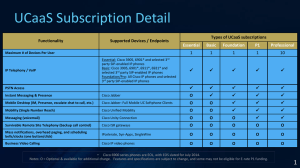
Understanding Cisco
Unified Communications
Manager Deployment
and Redundancy
Options
Getting Started with Cisco Unified Communications Manager
© 2008 Cisco Systems, Inc. All rights reserved.
CIPT1 v6.0—1-1
Outline
Cisco Unified Communications Manager Deployment Options
Cisco Unified Communications Manager Single-Site Deployment
Cisco Unified Communications Manager Multisite Deployment
with Centralized Call Processing
Cisco Unified Communications Manager Multisite Deployment
with Distributed Call Processing
Cisco Unified Communications Manager Multisite Deployment
with Clustering Over the WAN
Cisco Unified Communications Manager Call-Processing
Redundancy
© 2008 Cisco Systems, Inc. All rights reserved.
CIPT1 v6.0—1-2
Cisco Unified Communications Manager
Deployment Options
© 2008 Cisco Systems, Inc. All rights reserved.
CIPT1 v6.0—1-3
Cisco Unified Communications Manager
Deployment Options
Unified CM
Cluster
Applications
Unified CM
Cluster
Applications
PSTN
IP WAN
Branch
Headquarters
Supported IP telephony deployment models
Single-site deployment
Multisite WAN with centralized call processing
Multisite WAN with distributed call processing
Clustering over the IP WAN
© 2008 Cisco Systems, Inc. All rights reserved.
CIPT1 v6.0—1-4
Cisco Unified Communications Manager
Single-Site Deployment
© 2008 Cisco Systems, Inc. All rights reserved.
CIPT1 v6.0—1-5
Single-Site Deployment
Cisco Unified Communications
Manager servers, applications, and
DSP resources are at the same
physical location.
Cisco Unified
CM Cluster
IP WAN (if one) is used for data
traffic only; PSTN is used for all
external calls.
Supports approximately 30,000 IP
phones per cluster.
SIP/SCCP
PSTN
© 2008 Cisco Systems, Inc. All rights reserved.
CIPT1 v6.0—1-6
Single-Site: Design Guidelines
Understand the current calling patterns within the enterprise.
Use the G.711 codec; DSP resources can be allocated to other
functions, such as conferencing and MTP.
OffNet calls should be diverted to the PSTN or sent to the legacy
PBX.
Choose a uniform gateway for PSTN use.
Deploy the recommended network infrastructure.
Do not oversubscribe the Cisco Unified Communications Manager
and clustering capability.
© 2008 Cisco Systems, Inc. All rights reserved.
CIPT1 v6.0—1-7
Single-Site: Benefits
Ease of deployment
A common infrastructure for a converged solution
Simplified dial plan
No transcoding resources required, due to the use of only a single
high-bandwidth codec
© 2008 Cisco Systems, Inc. All rights reserved.
CIPT1 v6.0—1-8
Cisco Unified Communications Manager
Multisite Deployment with
Centralized Call Processing
© 2008 Cisco Systems, Inc. All rights reserved.
CIPT1 v6.0—1-9
Multisite WAN with Centralized
Call Processing
Cisco Unified
CM Cluster
Cisco Unified Communications Manager
at central site; applications and DSP
resources centralized or distributed.
IP WAN carries voice traffic and call
control signaling.
SIP/SCCP
Supports approximately 30,000 IP
phones per cluster.
Call admission control
(limit number of calls per site).
PSTN
IP
WAN
SRST for remote branches.
AAR used if WAN bandwidth is
exceeded.
SIP/SCCP
© 2008 Cisco Systems, Inc. All rights reserved.
SIP/SCCP
CIPT1 v6.0—1-10
Multisite WAN with Centralized Call
Processing: Design Guidelines
Maximum of 1000 locations per Cisco Unified Communications
Manager cluster.
Maximum of 1100 H.323 devices (gateways, MCUs, trunks, and
clients) or 1100 MGCP gateways per Cisco Unified
Communications Manager cluster.
Minimize delay between Cisco Unified Communications Manager
and remote locations to reduce voice cut-through delays.
Use the locations mechanism in Cisco Unified Communications
Manager to provide call admission control into and out of remote
branches.
SRST on the branch router limits remote offices to a maximum of
720 Cisco IP phones when using a Cisco 3845 Series router.
© 2008 Cisco Systems, Inc. All rights reserved.
CIPT1 v6.0—1-11
Multisite WAN with Centralized Call
Processing: Benefits
A common infrastructure for a converged solution.
PSTN call cost savings when using the IP WAN for calls between
sites.
Use of the IP WAN to bypass toll charges by routing calls through
remote site gateways, closer to the PSTN number dialed. This
practice is known as tail-end hop-off (TEHO).
Maximum utilization of available bandwidth by allowing voice
traffic to share the IP WAN with other types of traffic.
Use of Extension Mobility features between sites.
Use of AAR in the case of insufficient bandwidth.
Centralized administration.
© 2008 Cisco Systems, Inc. All rights reserved.
CIPT1 v6.0—1-12
Cisco Unified Communications Manager
Multisite Deployment with
Distributed Call Processing
© 2008 Cisco Systems, Inc. All rights reserved.
CIPT1 v6.0—1-13
Multisite WAN with Distributed
Call Processing
Cisco Unified
CM Cluster
Cisco Unified
Communications Manager
and applications are located
at each site.
SIP/SCCP
GK
IP WAN does not carry
intrasite call control signaling.
PSTN
Gatekeepers can be used for
scalability.
Gatekeeper
IP
WAN
Transparent use of the PSTN
if the IP WAN is unavailable.
SIP/SCCP
SIP/SCCP
Cisco Unified
CM Clusters
© 2008 Cisco Systems, Inc. All rights reserved.
CIPT1 v6.0—1-14
Multisite Distributed Call Processing:
Design Guidelines
Deploy a single WAN codec
Gatekeeper networks scale to hundreds of sites
– Implement a logical hub-and-spoke topology for the
gatekeeper
– Use gatekeeper redundancy
© 2008 Cisco Systems, Inc. All rights reserved.
CIPT1 v6.0—1-15
Multisite WAN with Distributed Call
Processing: Benefits
PSTN call cost savings when using the IP WAN for calls between
sites.
Use of the IP WAN to bypass toll charges by routing calls through
remote site gateways, closer to the PSTN number dialed, that is,
TEHO.
Maximum utilization of available bandwidth by allowing voice
traffic to share the IP WAN with other types of traffic.
No loss of functionality during IP WAN failure, because there is a
call-processing agent at each site.
© 2008 Cisco Systems, Inc. All rights reserved.
CIPT1 v6.0—1-16
Cisco Unified Communications Manager
Multisite Deployment with
Clustering Over the WAN
© 2008 Cisco Systems, Inc. All rights reserved.
CIPT1 v6.0—1-17
Clustering Over the IP WAN
Publisher / TFTP
<40-ms Round-Trip Delay
IP WAN
SIP/SCCP
QoS Enabled BW
SIP/SCCP
Applications and Cisco Unified Communications Manager of the
same cluster distributed over the IP WAN.
IP WAN carries intracluster server communication and signaling.
Limited number of sites.
© 2008 Cisco Systems, Inc. All rights reserved.
CIPT1 v6.0—1-18
Clustering Over the IP WAN:
Design Guidelines
40-ms maximum round-trip delay between any two Cisco Unified
Communications Manager servers in the cluster
Minimum 1.544 Mb/s and 900 kb/s for every 10,000 BHCAs within
the cluster
Up to eight small sites using the remote failover deployment
model
Failover across WAN supported (more bandwidth)
© 2008 Cisco Systems, Inc. All rights reserved.
CIPT1 v6.0—1-19
Clustering Over the IP WAN:
Benefits
PSTN call cost savings when using the IP WAN for calls between
sites.
Use of the IP WAN to bypass toll charges by routing calls through
remote site gateways, closer to the PSTN number dialed, that is,
TEHO.
Maximum utilization of available bandwidth by allowing voice
traffic to share the IP WAN with other types of traffic.
Failover across WAN is supported.
© 2008 Cisco Systems, Inc. All rights reserved.
CIPT1 v6.0—1-20
Cisco Unified Communications Manager
Call-Processing Redundancy
© 2008 Cisco Systems, Inc. All rights reserved.
CIPT1 v6.0—1-21
Cisco Unified Communications Manager
Redundancy
Maximum of eight call-processing servers in a cluster.
Redundancy is provided by Cisco Unified Communications
Manager groups.
– Prioritized list of call-processing servers (one or more).
– Multiple Cisco Unified Communications Manager groups can
exist in the same cluster.
– Each call-processing server can be assigned to more than one
Cisco Unified Communications Manager group.
– Each device has a Cisco Unified Communications Manager
group assigned determines the primary and backup server to
which it will register.
© 2008 Cisco Systems, Inc. All rights reserved.
CIPT1 v6.0—1-22
1:1 Redundancy Design
Primary
Secondary or
Backup
7500 IP phones
Cisco MCS 7845
Publisher and
TFTP Server
(Not Req.
<1000)
Primary
1 to 7500
High availability (upgrade)
Increased server count
Simplified configuration
15,000 IP phones
Cisco MCS 7845
Publisher and
TFTP Server
Backups
1 to
7500
30,000 IP phones
Cisco MCS 7845
Publisher and
TFTP Server
Backups
7501 to
15,000
1 to
7500
7501 to
15,000
Backup
Backups
15001 to
22,500
22,501 to
30,000
© 2008 Cisco Systems, Inc. All rights reserved.
CIPT1 v6.0—1-23
2:1 Redundancy Design
Primary
Secondary or
Backup
7500 IP phones
Cisco MCS 7845
Publisher and
TFTP Server
(Not Req.
<1000)
Primary
1 to 7500
Cost-efficient redundancy
Service impacted during upgrade
15,000 IP phones
Cisco MCS 7845
Publisher and
TFTP Server
Backup
1 to
7500
30,000 IP phones
Cisco MCS 7845
Publisher and
TFTP Server
Backup
7501 to
15,000
1 to
7500
7501 to
15,000
Backup
Backup
15,001 to
22,500
22,501 to
30,000
© 2008 Cisco Systems, Inc. All rights reserved.
CIPT1 v6.0—1-24
Summary
Supported Cisco Unified Communications Manager deployment
models are single-site, multisite with centralized call processing,
multisite with distributed call processing, and clustering over the
IP WAN.
In the single-site deployment model, the Cisco Unified
Communications Manager, applications, and DSP resources are
at the same physical location; all off-site calls are handled by the
PSTN.
The multisite with centralized call-processing model has a single
Cisco Unified Communications Manager cluster; applications and
DSP resources can be centralized or distributed; the IP WAN
carries call control signaling traffic even for calls within a remote
site.
© 2008 Cisco Systems, Inc. All rights reserved.
CIPT1 v6.0—1-25
Summary (Cont.)
The multisite with distributed call-processing model has multiple
independent sites, each with a Cisco Unified Communications
Manager cluster; the IP WAN carries traffic only for intersite calls.
Clustering over the WAN provides centralized administration, a
unified dial plan, feature extension to all offices, and support for
more remote phones during failover. But it also places strict delay
and bandwidth requirements on the WAN.
Clusters provide redundancy. A 1:1 redundancy design offers
thehighest availability but requires the most resources and is not
as cost-effective as 1:2 redundancy.
© 2008 Cisco Systems, Inc. All rights reserved.
CIPT1 v6.0—1-26
© 2008 Cisco Systems, Inc. All rights reserved.
CIPT1 v6.0—1-27









